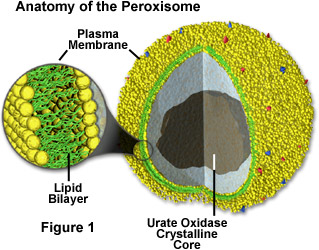

Peroxisomes are globular organelles, of approximately 1 microm in diameter, that are found ubiquitously in eukaryotic cells. In higher plants, peroxisomes have been believed to play a pivotal role in three metabolic pathways: lipid breakdown, photorespiration and H2O2-detoxificaton. However, recent progress using Arabidopsis mutants has suggested that peroxisomes have more diverse functions than are known at present.
Peroxisomes were discovered by Christian de Duve in 1965. Unlike lysosomes, which are formed in the secretory pathway, peroxisomes usually self-replicate by enlarging and then dividing, although there is some indication new ones may be formed directly. They also have membrane proteins that are critical for various functions, such as for importing proteins into their interiors and to proliferate and segregate into daughter cells.
Peroxisomes are thought to be a vestige of an ancient organelle that performed all the oxygen metabolism in the primitive ancestors of eukaryotic cells. When the oxygen produced by photosynthetic bacteria first began to accumulate in the atmosphere, it would have been highly toxic to most cells. Peroxisomes might have served to lower the intracellular concentration of oxygen, while at the same time exploiting its chemical reactivity to perform useful oxidative reactions. Peroxisomes were largely rendered obsolete at the arrival of the mitochondria, which coupled the oxidative reactions to ATP formation by means of oxidative phosphorylation. The oxidative reactions performed by the peroxisomes in present-day cells would therefore be those that have important functions not taken over by the mitochondria. Peroxisomes are actually made out of lipids. The Peroxisomes are stored in the nucleous and and later used as fuel for the mitochondria. It can also be used for fuel by itself. Other Peroxisomes will actually use other Peroxisomes in time of need.
Peroxisomes consists of a single membrane which separates them from the cytosol (the internal fluid of the cell). Like the ER they are self-replicating by enlarging and dividing, although there is some indication new ones may be formed directly, like the lysosomes. Proteins are selectively imported, and since they contain no DNA or ribosomes, all of their proteins must be imported.
Peroxisomes contain oxidative enzymes, such as catalase, D-amino acid oxidase and uric acid oxidase. By using molecular oxygen hydrogen atoms are removed from specific organic substrates (R), in an oxidative reaction, producing hydrogen peroxide (H202 , a toxic byproduct of cellular metabolism).
RH2 + O2 -> R + H202
Catalase uses H202 generated by other enzymes in the peroxisome to oxidize other substrates, including phenols, formic acid, formaldehyde and alcohol, by means of the peroxidation reaction:
H202 + R'H2 -> R' + 2H2o
This reaction is important in liver and kidney cells were the peroxisomes detoxifies various toxic substances that enter the blood. About 25% of the ethanol we drin is oxidized to acetalaldehyde in this way. In addition, when excess H202 accumulates in the cell, catalase converts it to H2O througj this reaction:
2H202 -> 2H20 + O2
A major function of the peroxisome is the break-down of fatty acid molecules, in a process called beta-ixidation. In this process the fatty acids are broken down two carbons at a time, which is converted to Acetyl-CoA, which is then transported back to the cytosol for furhter use. In animal cells the beta-oxidation can also occur in the mitochondria. In yeast and plant cells this process is exclusive for the peroxisome.
Peroxisomes catalyzes the firt reactions in the formation of plasmalogen, which is the most abundant phospholipid in myelin. Deficiency of plasmalogens causes profund abnormalities in the myelination of nerve cells, which is on reason why many peroximal disorders lead to neurological disease.
Peroxisomes also play a role in the bile acids production.
A specific protein signal (PTS or peroxisomal targeting signal) of three amino acids at the C-terminus of many peroxisomal proteins signals the peroxisome to import them. Other peroxisomal proteins contain a signal at the N-terminus. Thera are at least 23 know peroxisomal proteins, called peroxins, which participates in the process of importing proteins by means of ATP hydrolysis. Proteins do not have to unfold to be imported into the peroxisome. At least on protein receptor, the peroxin Pex5, accompanies its cargo all the way into the peroxisome were it releases it and then returns to the cytosol.